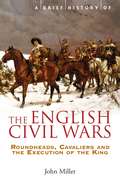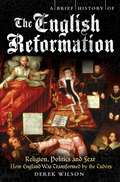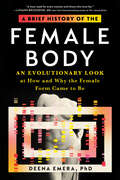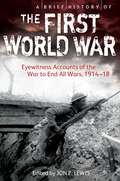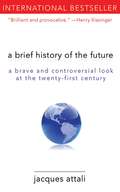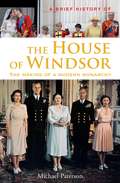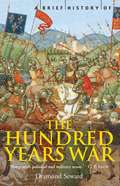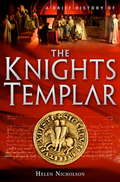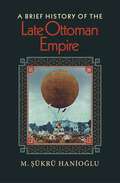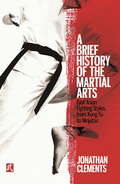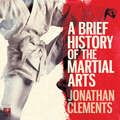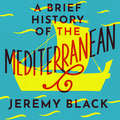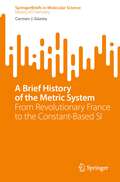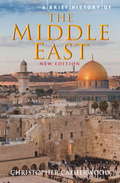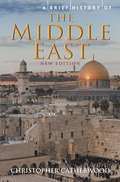- Table View
- List View
A Brief History of the English Civil Wars: Roundheads, Cavaliers and the Execution of the King (Brief Histories)
by Professor John MillerMiller provides a clear and comprehensible narrative, a coherent and accurate synthesis, intended as a guide for students and the general reader to an extremely complex period in British history. His aim is to help readers avoid getting lost in a maze of detail and rather to maintain a grasp of the big picture. Although the English Civil War is usually seen, in England at least, as a conflict between two sides, it involved the Scots, the Irish and the army and the people of England, especially London. At some points, events occurred and perspectives changed with such disorienting rapidity that even those who lived through these events were confused as to where they stood in relation to one another.As the 1640s wore on, events unfolded in ways which the participants had not expected and in many cases did not want. Hindsight might suggest that everything led logically to the trial and execution of the king, but these were in fact highly improbable outcomes.Since the 1980s, a 'three kingdoms' approach has become almost compulsory, but Miller's focus is unashamedly on England. Events in Scotland and Ireland are covered only insofar as they had an impact on events in England.
A Brief History of the English Civil Wars: Roundheads, Cavaliers and the Execution of the King (Brief History Ser.)
by John MillerThe English Civil War is one of the most hotly contested areas of English History and John Miller is one of the experts on the period. Amid dramatic accounts of the key battles and confrontations, Miller explores what triggered the initial conflict between crown and parliament and how this was played out in England, Scotland and Ireland in the lead-up to war. As the war developed, personalities and innovations on the battlefield became increasingly important, culminating in the rise of Oliver Cromwell and the radical New Model Army. The wars changed the political, social, religious and intellectual landscape of the country for ever. Using a lifetime's knowledge and study on the period, John Miller brings this extraordinary turning point in British history to life.
A Brief History of the English Reformation
by Derek WilsonReligion, politics and fear: how England was transformed by the Tudors.The English Reformation was a unique turning point in English history. Derek Wilson retells the story of how the Tudor monarchs transformed English religion and why it still matters today. Recent scholarly research has undermined the traditional view of the Reformation as an event that occurred solely amongst the elite. Wilson now shows that, although the transformation was political and had a huge impact on English identity, on England's relationships with its European neighbours and on the foundations of its empire, it was essentially a revolution from the ground up. By 1600, in just eighty years, England had become a radically different nation in which family, work and politics, as well as religion, were dramatically altered.
A Brief History of the English Reformation (Brief Histories)
by Mr Derek WilsonReligion, politics and fear: how England was transformed by the Tudors.The English Reformation was a unique turning point in English history. Derek Wilson retells the story of how the Tudor monarchs transformed English religion and why it still matters today. Recent scholarly research has undermined the traditional view of the Reformation as an event that occurred solely amongst the elite. Wilson now shows that, although the transformation was political and had a huge impact on English identity, on England's relationships with its European neighbours and on the foundations of its empire, it was essentially a revolution from the ground up. By 1600, in just eighty years, England had become a radically different nation in which family, work and politics, as well as religion, were dramatically altered. Praise for Derek Wilson:'Stimulating and authoritative.' John Guy.'Masterly. [Wilson] has a deep understanding of . . . characters, reaching out across the centuries.' Sunday Times.
A Brief History of the Female Body: An Evolutionary Look at How and Why the Female Form Came to Be
by Dr. Deena EmeraFrom breasts and orgasms to periods, pregnancies, and menopause—A Brief History of the Female Body is a fascinating science book explaining the mysteries of the female body through an evolutionary lens.Let's face it: The female body is an enigma. For teenagers first experiencing their periods, the monthly arrival of mood swings and cramps can be agonizing and inconvenient. With pregnancy—perhaps the most miraculous of bodily events—comes countless potential complications, including high blood pressure, diabetes, premature birth, and postpartum depression. And menopause is equally mystifying. Why do females lose their fertility over time and experience the notorious side effects—like hot flashes, weight gain, and hair loss—while males maintain their fertility forever?Evolutionary geneticist and educator Dr. Deena Emera has spent much of her career studying the evolution of female reproduction. A Brief History of the Female Body draws on her vast expertise as a biologist, her experience as a mother of four children, and her love of teaching to look far into our evolutionary past, illuminating how and, more importantly, why the female form has transformed over millions of years and its effects on women's health.
A Brief History of the First World War: Eyewitness Accounts of the War to End All Wars, 1914-18
by Jon E. LewisEven 100 years on from the First World War it haunts us still. No other conflict has revealed so dramatically the senselessness of war, and none has shaped the modern world to the same extent, from its impact on the Russian Revolution and the rise of Hitler to the final break-up of the British Empire and the supremacy of America. These compelling eyewitness accounts - over 180 of them - of the War to End All Wars cover every facet of the war, from the Flanders trenches to the staffrooms of the Imperial German Army, from T. E. Lawrence ('Lawrence of Arabia') in the desert to German figher ace the Red Baron in the air, and from English Land Girls to German U-boat crews in the North Atlantic. There are contributions from all combatant nations, including the UK, USA, France, Germany, Canada, Italy, Australia, Russia, Serbia, and India and the book includes a detailed timeline and maps.
A Brief History of the First World War: Eyewitness Accounts of the War to End All Wars, 1914–18 (Brief Histories)
by Jon E. LewisEven 100 years on from the First World War it haunts us still. No other conflict has revealed so dramatically the senselessness of war, and none has shaped the modern world to the same extent, from its impact on the Russian Revolution and the rise of Hitler to the final break-up of the British Empire and the supremacy of America. These compelling eyewitness accounts - over 180 of them - of the War to End All Wars cover every facet of the war, from the Flanders trenches to the staffrooms of the Imperial German Army, from T. E. Lawrence ('Lawrence of Arabia') in the desert to German figher ace the Red Baron in the air, and from English Land Girls to German U-boat crews in the North Atlantic. There are contributions from all combatant nations, including the UK, USA, France, Germany, Canada, Italy, Australia, Russia, Serbia, and India and the book includes a detailed timeline and maps.
A Brief History of the Flathead Tribes (3rd edition)
by the Flathead Culture Committee of the Confederated Salish & Kootenai TribesAfter being forcefully deprived of much of their land when The reservation was opened to white settlement in 1910, the tribe has worked hard to regain control over tribal affairs and re-establish their economic independence.
A Brief History of the Future: A Brave and Controversial Look at the Twenty-First Century
by Jeremy Leggatt Jacques AttaliWhat will planet Earth be like in twenty years? At mid-century? In the year 2100? Prescient and convincing, this book is a must-read for anyone concerned about the future. Never has the world offered more promise for the future and been more fraught with dangers. Attali anticipates an unraveling of American hegemony as transnational corporations sever the ties linking free enterprise to democracy. World tensions will be primed for horrific warfare for resources and dominance. The ultimate question is: Will we leave our children and grandchildren a world that is not only viable but better, or in this nuclear world bequeath to them a planet that will be a living hell? Either way, he warns, the time to act is now.
A Brief History of the House of Windsor: The Making Of A Modern Monarchy
by Michael PatersonThe British monarchy may be over a thousand years old, but the House of Windsor dates only from 1917, when, in the middle of the First World War that was to see the demise of the major thrones of continental Europe, it rebranded itself from the distinctly Germanic Saxe-Coburg-Gotha to the homely and familiar Windsor. By redefining its loyalties to identify with its people and country rather than the princes, kings and emperors of Europe to whom it was related by birth and marriage, it set the monarchy on the path of adaptation, making itself relevant and allowing it to survive. Since then, the fine line trodden by the House of Windsor between ancient and modern, grandeur and thrift, splendour and informality, remoteness and accessibility, and influence and neutrality has left it more secure and its appeal more universal today than ever.
A Brief History of the House of Windsor: The Making of a Modern Monarchy (Brief Histories)
by Michael PatersonThe British monarchy may be over a thousand years old, but the House of Windsor dates only from 1917, when, in the middle of the First World War that was to see the demise of the major thrones of continental Europe, it rebranded itself from the distinctly Germanic Saxe-Coburg-Gotha to the homely and familiar Windsor. By redefining its loyalties to identify with its people and country rather than the princes, kings and emperors of Europe to whom it was related by birth and marriage, it set the monarchy on the path of adaptation, making itself relevant and allowing it to survive. Since then, the fine line trodden by the House of Windsor between ancient and modern, grandeur and thrift, splendour and informality, remoteness and accessibility, and influence and neutrality has left it more secure and its appeal more universal today than ever.
A Brief History of the Hundred Years War: The English in France, 1337-1453
by Desmond SewardFor over a hundred years England repeatedly invaded France on the pretext that her kings had a right to the French throne. France was a large, unwieldy kingdom, England was small and poor, but for the most part she dominated the war, sacking towns and castles and winning battles - including such glorious victories as Crecy, Poitiers and Agincourt, but then the English run of success began to fail, and in four short years she lost Normandy and finally her last stronghold in Guyenne. The protagonists of the Hundred Year War are among the most colourful in European history: for the English, Edward III, the Black Prince and Henry V, later immortalized by Shakespeare; for the French, the splendid but inept John II, who died a prisoner in London, Charles V, who very nearly overcame England and the enigmatic Charles VII, who did at last drive the English out.
A Brief History of the Hundred Years War: The English in France, 1337-1453 (Brief Histories)
by Mr Desmond SewardFor over a hundred years England repeatedly invaded France on the pretext that her kings had a right to the French throne. France was a large, unwieldy kingdom, England was small and poor, but for the most part she dominated the war, sacking towns and castles and winning battles - including such glorious victories as Crecy, Poitiers and Agincourt, but then the English run of success began to fail, and in four short years she lost Normandy and finally her last stronghold in Guyenne. The protagonists of the Hundred Year War are among the most colourful in European history: for the English, Edward III, the Black Prince and Henry V, later immortalized by Shakespeare; for the French, the splendid but inept John II, who died a prisoner in London, Charles V, who very nearly overcame England and the enigmatic Charles VII, who did at last drive the English out.
A Brief History of the Knights Templar: The Trial Of The Templars In The British Isles, 1308-1311 (Brief Histories)
by Professor in Med Helen NicholsonMuch has been written about the Knights Templar in recent years. A leading specialist in the history of this legendary medieval order now writes a full account of the Knights of the Order of the Temple of Solomon, to give them their full title, bringing the latest findings to a general audience. Putting many of the myths finally to rest, Nicholson recounts a new history of these storm troopers of the papacy, founded during the crusades but who got so rich and influential that they challenged the power of kings.
A Brief History of the Late Ottoman Empire
by M. Şükrü HanioğluAt the turn of the nineteenth century, the Ottoman Empire straddled three continents and encompassed extraordinary ethnic and cultural diversity among the estimated thirty million people living within its borders. It was perhaps the most cosmopolitan state in the world--and possibly the most volatile. A Brief History of the Late Ottoman Empire now gives scholars and general readers a concise history of the late empire between 1789 and 1918, turbulent years marked by incredible social change. Moving past standard treatments of the subject, M. Sükrü Hanioglu emphasizes broad historical trends and processes more than single events. He examines the imperial struggle to centralize amid powerful opposition from local rulers, nationalist and other groups, and foreign powers. He looks closely at the socioeconomic changes this struggle wrought and addresses the Ottoman response to the challenges of modernity. Hanioglu shows how this history is not only essential to comprehending modern Turkey, but is integral to the histories of Europe and the world. He brings Ottoman society marvelously to life in all its facets--cultural, diplomatic, intellectual, literary, military, and political--and he mines imperial archives and other documents from the period to describe it as it actually was, not as it has been portrayed in postimperial nationalist narratives. A Brief History of the Late Ottoman Empire is a must-read for anyone seeking to understand the legacy left in this empire's ruins--a legacy the world still grapples with today.
A Brief History of the Martial Arts: East Asian Fighting Styles, from Kung Fu to Ninjutsu (Brief Histories Ser.)
by Jonathan ClementsFolk tales of the Shaolin Temple depict warrior monks with superhuman abilities. Today, dozens of East Asian fighting styles trace their roots back to the Buddhist brawlers of Shaolin, although any quest for the true story soon wanders into a labyrinth of forgeries, secret texts and modern retellings.This new study approaches the martial arts from their origins in military exercises and callisthenics. It examines a rich folklore from old wuxia tales of crime-fighting heroes to modern kung fu movies. Centre stage is given to the stories that martial artists tell themselves about themselves, with accounts (both factual and fictional) of famous practitioners including China's Yim Wing-chun, Wong Fei-hong, and Ip Man, as well as Japanese counterparts such as Kano Jigoro, Itosu Anko and So Doshin.The history of martial arts encompasses secret societies and religious rebels, with intimate glimpses of the histories of China, Korea and Japan, their conflicts and transformations. The book also charts the migration of martial arts to the United States and beyond. Special attention is paid to the turmoil of the twentieth century, the cross-cultural influence of Japanese colonies in Asia, and the post-war rise of martial arts in sport and entertainment - including the legacy of Bruce Lee, the dilemma of the ninja and the global audience for martial arts in fiction.
A Brief History of the Martial Arts: East Asian Fighting Styles, from Kung Fu to Ninjutsu (Brief Histories)
by Jonathan Clements'If I had to pick a single general martial arts history book in English, I would recommend A Brief History of the Martial Arts by Dr Jonathan Clements' RICHARD BEITLICH, Martial History Team blogFrom Shaolin warrior monks to the movies of Bruce Lee, a new history of the evolution of East Asian styles of unarmed combat, from Kung Fu to NinjutsuFolk tales of the Shaolin Temple depict warrior monks with superhuman abilities. Today, dozens of East Asian fighting styles trace their roots back to the Buddhist brawlers of Shaolin, although any quest for the true story soon wanders into a labyrinth of forgeries, secret texts and modern retellings.This new study approaches the martial arts from their origins in military exercises and callisthenics. It examines a rich folklore from old wuxia tales of crime-fighting heroes to modern kung fu movies. Centre stage is given to the stories that martial artists tell themselves about themselves, with accounts (both factual and fictional) of famous practitioners including China's Yim Wing-chun, Wong Fei-hong, and Ip Man, as well as Japanese counterparts such as Kano Jigoro, Itosu Anko and So Doshin.The history of martial arts encompasses secret societies and religious rebels, with intimate glimpses of the histories of China, Korea and Japan, their conflicts and transformations. The book also charts the migration of martial arts to the United States and beyond. Special attention is paid to the turmoil of the twentieth century, the cross-cultural influence of Japanese colonies in Asia, and the post-war rise of martial arts in sport and entertainment - including the legacy of Bruce Lee, the dilemma of the ninja and the global audience for martial arts in fiction.
A Brief History of the Martial Arts: East Asian Fighting Styles, from Kung Fu to Ninjutsu (Brief Histories)
by Jonathan Clements'If I had to pick a single general martial arts history book in English, I would recommend A Brief History of the Martial Arts by Dr Jonathan Clements' RICHARD BEITLICH, Martial History Team blogFrom Shaolin warrior monks to the movies of Bruce Lee, a new history of the evolution of East Asian styles of unarmed combat, from Kung Fu to NinjutsuFolk tales of the Shaolin Temple depict warrior monks with superhuman abilities. Today, dozens of East Asian fighting styles trace their roots back to the Buddhist brawlers of Shaolin, although any quest for the true story soon wanders into a labyrinth of forgeries, secret texts and modern retellings.This new study approaches the martial arts from their origins in military exercises and callisthenics. It examines a rich folklore from old wuxia tales of crime-fighting heroes to modern kung fu movies. Centre stage is given to the stories that martial artists tell themselves about themselves, with accounts (both factual and fictional) of famous practitioners including China's Yim Wing-chun, Wong Fei-hong, and Ip Man, as well as Japanese counterparts such as Kano Jigoro, Itosu Anko and So Doshin.The history of martial arts encompasses secret societies and religious rebels, with intimate glimpses of the histories of China, Korea and Japan, their conflicts and transformations. The book also charts the migration of martial arts to the United States and beyond. Special attention is paid to the turmoil of the twentieth century, the cross-cultural influence of Japanese colonies in Asia, and the post-war rise of martial arts in sport and entertainment - including the legacy of Bruce Lee, the dilemma of the ninja and the global audience for martial arts in fiction.
A Brief History of the Mediterranean: Indispensable for Travellers
by Jeremy BlackA wonderfully concise and readable, yet comprehensive, history of the Mediterranean Sea, the perfect companion for any visitor -- or indeed, anyone compelled to stay at home.'The grand object of travelling is to see the shores of the Mediterranean.'Samuel Johnson, 1776The Mediterranean has always been a leading stage for world history; it is also visited each year by tens of millions of tourists, both local and international. Jeremy Black provides an account in which the experience of travel is foremost: travel for tourism, for trade, for war, for migration, for culture, or, as so often, for a variety of reasons. Travellers have always had a variety of goals and situations, from rulers to slaves, merchants to pirates, and Black covers them all, from Phoenicians travelling for trade to the modern tourist sailing for pleasure and cruising in great comfort.Throughout the book the emphasis is on the sea, on coastal regions and on port cities visited by cruise liners - Athens, Barcelona, Naples, Palermo. But it also looks beyond, notably to the other waters that flow into the Mediterranean - the Black Sea, the Atlantic, the Red Sea and rivers, from the Ebro and Rhone to the Nile. Much of western Eurasia and northern Africa played, and continues to play, a role, directly or indirectly, in the fate of the Mediterranean. At times, that can make the history of the sea an account of conflict after conflict, but it is necessary to understand these wars in order to grasp the changing boundaries of the Mediterranean states, societies and religions, the buildings that have been left, and the peoples' cultures, senses of identity and histories.Black explores the centrality of the Mediterranean to the Western experience of travel, beginning in antiquity with the Phoenicians, Minoans and Greeks. He shows how the Roman Empire united the sea, and how it was later divided by Christianity and Islam. He tells the story of the rise and fall of the maritime empires of Pisa, Genoa and Venice, describes how galley warfare evolved and how the Mediterranean fired the imagination of Shakespeare, among many artists. From the Renaissance and Baroque to the seventeenth-century beginnings of English tourism - to the Aegean, Sicily and other destinations - Black examines the culture of the Mediterraean. He shows how English naval power grew, culminating in Nelson's famous victory over the French in the Battle of the Nile and the establishment of Gibraltar, Minorca and Malta as naval bases. Black explains the retreat of Islam in north Africa, describes the age of steam navigation and looks at how and why the British occupied Cyprus, Egypt and the Ionian Islands. He looks at the impact of the Suez Canal as a new sea route to India and how the Riviera became Europe's playground. He shows how the Mediterranean has been central to two World Wars, the Cold War and ongoing conflicts in the Middle East. With its focus always on the Sea, the book looks at the fate of port cities particularly - Alexandria, Salonika and Naples.
A Brief History of the Mediterranean: Indispensable for Travellers
by Jeremy BlackA wonderfully concise and readable, yet comprehensive, history of the Mediterranean Sea, the perfect companion for any visitor -- or indeed, anyone compelled to stay at home.'The grand object of travelling is to see the shores of the Mediterranean.'Samuel Johnson, 1776The Mediterranean has always been a leading stage for world history; it is also visited each year by tens of millions of tourists, both local and international. Jeremy Black provides an account in which the experience of travel is foremost: travel for tourism, for trade, for war, for migration, for culture, or, as so often, for a variety of reasons. Travellers have always had a variety of goals and situations, from rulers to slaves, merchants to pirates, and Black covers them all, from Phoenicians travelling for trade to the modern tourist sailing for pleasure and cruising in great comfort.Throughout the book the emphasis is on the sea, on coastal regions and on port cities visited by cruise liners - Athens, Barcelona, Naples, Palermo. But it also looks beyond, notably to the other waters that flow into the Mediterranean - the Black Sea, the Atlantic, the Red Sea and rivers, from the Ebro and Rhone to the Nile. Much of western Eurasia and northern Africa played, and continues to play, a role, directly or indirectly, in the fate of the Mediterranean. At times, that can make the history of the sea an account of conflict after conflict, but it is necessary to understand these wars in order to grasp the changing boundaries of the Mediterranean states, societies and religions, the buildings that have been left, and the peoples' cultures, senses of identity and histories.Black explores the centrality of the Mediterranean to the Western experience of travel, beginning in antiquity with the Phoenicians, Minoans and Greeks. He shows how the Roman Empire united the sea, and how it was later divided by Christianity and Islam. He tells the story of the rise and fall of the maritime empires of Pisa, Genoa and Venice, describes how galley warfare evolved and how the Mediterranean fired the imagination of Shakespeare, among many artists. From the Renaissance and Baroque to the seventeenth-century beginnings of English tourism - to the Aegean, Sicily and other destinations - Black examines the culture of the Mediterraean. He shows how English naval power grew, culminating in Nelson's famous victory over the French in the Battle of the Nile and the establishment of Gibraltar, Minorca and Malta as naval bases. Black explains the retreat of Islam in north Africa, describes the age of steam navigation and looks at how and why the British occupied Cyprus, Egypt and the Ionian Islands. He looks at the impact of the Suez Canal as a new sea route to India and how the Riviera became Europe's playground. He shows how the Mediterranean has been central to two World Wars, the Cold War and ongoing conflicts in the Middle East. With its focus always on the Sea, the book looks at the fate of port cities particularly - Alexandria, Salonika and Naples.
A Brief History of the Mediterranean: Indispensable for Travellers
by Jeremy BlackA wonderfully concise and readable, yet comprehensive, history of the Mediterranean Sea, the perfect companion for any visitor -- or indeed, anyone compelled to stay at home.'The grand object of travelling is to see the shores of the Mediterranean.'Samuel Johnson, 1776The Mediterranean has always been a leading stage for world history; it is also visited each year by tens of millions of tourists, both local and international. Jeremy Black provides an account in which the experience of travel is foremost: travel for tourism, for trade, for war, for migration, for culture, or, as so often, for a variety of reasons. Travellers have always had a variety of goals and situations, from rulers to slaves, merchants to pirates, and Black covers them all, from Phoenicians travelling for trade to the modern tourist sailing for pleasure and cruising in great comfort.Throughout the book the emphasis is on the sea, on coastal regions and on port cities visited by cruise liners - Athens, Barcelona, Naples, Palermo. But it also looks beyond, notably to the other waters that flow into the Mediterranean - the Black Sea, the Atlantic, the Red Sea and rivers, from the Ebro and Rhone to the Nile. Much of western Eurasia and northern Africa played, and continues to play, a role, directly or indirectly, in the fate of the Mediterranean. At times, that can make the history of the sea an account of conflict after conflict, but it is necessary to understand these wars in order to grasp the changing boundaries of the Mediterranean states, societies and religions, the buildings that have been left, and the peoples' cultures, senses of identity and histories.Black explores the centrality of the Mediterranean to the Western experience of travel, beginning in antiquity with the Phoenicians, Minoans and Greeks. He shows how the Roman Empire united the sea, and how it was later divided by Christianity and Islam. He tells the story of the rise and fall of the maritime empires of Pisa, Genoa and Venice, describes how galley warfare evolved and how the Mediterranean fired the imagination of Shakespeare, among many artists. From the Renaissance and Baroque to the seventeenth-century beginnings of English tourism - to the Aegean, Sicily and other destinations - Black examines the culture of the Mediterraean. He shows how English naval power grew, culminating in Nelson's famous victory over the French in the Battle of the Nile and the establishment of Gibraltar, Minorca and Malta as naval bases. Black explains the retreat of Islam in north Africa, describes the age of steam navigation and looks at how and why the British occupied Cyprus, Egypt and the Ionian Islands. He looks at the impact of the Suez Canal as a new sea route to India and how the Riviera became Europe's playground. He shows how the Mediterranean has been central to two World Wars, the Cold War and ongoing conflicts in the Middle East. With its focus always on the Sea, the book looks at the fate of port cities particularly - Alexandria, Salonika and Naples.
A Brief History of the Metric System: From Revolutionary France to the Constant-Based SI (SpringerBriefs in Molecular Science)
by Carmen J. GiuntaThis book succinctly traces the history of the metric system from early modern proposals of decimal measures, to the birth of the system in Revolutionary France, through its formal international adoption under the supervision of an international General Committee of Weights and Measures (CGPM), to its later expansion into the International System of Units (SI), currently formulated entirely in terms of physical constants. The wide range of human activities that employ weights and measures, from practical commerce to esoteric science, influenced both the development and the diffusion of the metric system. The roles of constants of nature in the formulation of the 18th-century metric system and in the 21st-century reformulation of the SI are described. Finally, the status of the system in the United States, the last major holdout against its everyday use, is also discussed.
A Brief History of the Middle East (Brief Histories)
by Christopher CatherwoodWestern civilization began in the Middle East: Judaism and Christianity, as well as Islam, were born there. For over a millennium, the Islamic empires were ahead of the West in learning, technology and medicine, and were militarily far more powerful. It took another three hundred centuries for the West to catch up, and overtake, the Middle East.Why does it seem different now? Why does Osama bin Laden see 1918, with the fall of the Ottoman Empire, as the year everything changed? These issues are explained in historical detail here, in a way that deliberately seeks to go behind the rhetoric to the roots of present conflicts. A Brief History of the Middle East is essential reading for an intelligent reader wanting to understand what one of the world's key regions is all about. Fully updated with a new section on the Iraq Invasion of 2003, the question of Iran and the full context of the Isreali/Palestine conflict.
A Brief History of the Middle East (Second Edition)
by Christopher CatherwoodFor over a millennium, the Islamic empires were ahead of the West in learning, technology, and medicine, and were militarily far more powerful. It took another three hundred years for the West to catch up and overtake the Middle East. In this fully updated and revised edition, historian Christopher Catherwood brings the account up to the present day and places in context the continuing friction between Israel and Palestine, the aftermath of the Iraq conflict, and the rising threat of Iran.
A Brief History of the Middle East: From Abraham To Arafat (Brief Histories )
by Christopher CatherwoodWestern civilization began in the Middle East: Judaism and Christianity, as well as Islam, were born there. For over a millennium, the Islamic empires were ahead of the West in learning, technology and medicine, and were militarily far more powerful. It took another three hundred centuries for the West to catch up, and overtake, the Middle East.Why does it seem different now? Why does Osama bin Laden see 1918, with the fall of the Ottoman Empire, as the year everything changed? These issues are explained in historical detail here, in a way that deliberately seeks to go behind the rhetoric to the roots of present conflicts. A Brief History of the Middle East is essential reading for an intelligent reader wanting to understand what one of the world's key regions is all about. Fully updated with a new section on the Iraq Invasion of 2003, the question of Iran and the full context of the Isreali/Palestine conflict.
